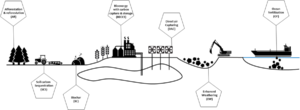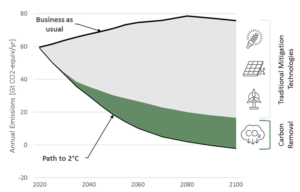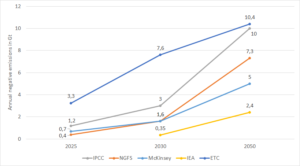Compliance emissions markets (such as the European emission trading system) are an important climate protection instrument in Germany, Europe and increasingly also internationally. Mandatory emissions markets are organised by states or regions and price the emissions of companies. The markets are strongly influenced by politics, are constantly evolving and are becoming increasingly complex.
In order to meet global climate targets, the avoidance and reduction of emissions is a priority. However, the technologies needed for this are not yet available in the medium term, so according to the Intergovernmental Panel on Climate Change (IPCC) the large-scale use of carbon removal technologies and solutions is necessary.
Companies can purchase carbon removal certificates on voluntary emissions markets in order to achieve their own climate targets. In doing so, they also support global efforts to combat climate change. The voluntary carbon markets are growing dynamically and offer carbon removal credits of different qualities (e.g. price, additionality, irreversibility or longevity).
More and more companies are setting ambitious climate targets to achieve climate neutrality. The achievement of these targets has to be based on a comprehensive understanding of the concept of carbon neutrality, possible transformation pathways and implications for the company’s business model. Climate strategies must meet various requirements which are set out in different international standards (e.g. SBTi).
We offer you and your staff a comprehensive range of professional development and training. You can benefit from our expert knowledge on carbon markets and climate neutrality through seminars, workshops or lectures. We help you to stay up to date and provide professional development for your staff. In addition, we deliver tailored market reports and analyses on all relevant topics.
Our
services
EU Carbon Markets
The compliance CO2 markets are among the most important climate protection instruments in the EU and thus also in Germany. Whether nEHS, EU ETS I, EU ETS II or CBAM: With our expertise you know which rules apply, what is currently being developed and what impact this will have on your company. With our know-how you can prepare and educate yourself in the best possible way.
Affected companies
Political and regulatory framework
Price development and forecasts
ToDos and guidance for compliant companies
CCUS and Carbon Dioxide Removal
Achieving carbon neutrality in businesses and national economies requires the extensive use of carbon removal technologies and processes. Use our market knowledge to understand current developments and what role Carbon Dioxide Removal (CDR) can play for your business.
Relevance of CDR for national and global climate targets
Available technologies and state of development
Market overview and price development
Political and regulatory framework
Carbon removal in the corporate context
Climate Neutrality Strategy
Many international corporations and small and medium-sized enterprises are developing their own corporate climate targets. Learn which international standards are used for climate targets and climate neutrality and how you can equip yourself well for implementation.
Basics of corporate climate strategies and targets.
International standards (e.g. SBTi) for companies
Structure and implementation of climate targets
Emission pathways and unavoidable emissions
Real-life examples
Contact us to discuss further details.
We are happy to tailor our trainings and market insights according to your needs.
+49 176 88 31 70 54
FAQ
Which energy and climate targets has the EU set for itself?
In the EU Green Deal and the Fit for 55 package, the EU has set itself ambitious energy and climate policy goals. The share of renewable energies in final energy consumption is to increase to 40 percent by 2030 and even to 45 percent according to the new REPowerEU strategy to reduce import dependence on Russian fossil fuels. Greenhouse gas emissions are to fall by at least 55 percent by 2030 compared to 1990. By 2050, the EU is to be climate neutral.
What is the EU ETS?
The European Emissions Trading Scheme (EU ETS) has been the EU’s central climate protection instrument since 2005- and covers about 40 % of the EU-wide greenhouse gas emissions. It aims to reduce greenhouse gas emissions in the participating energy sector, energy-intensive industry, aviation and shipping. The EU ETS works according to the principle of “cap & trade”. A cap determines the total amount of greenhouse gas emissions that may be emitted by installations subject to emissions trading. The emission allowances can be freely traded on the market. This creates a price for the emission of greenhouse gases. This price creates incentives for the participating companies to reduce their greenhouse gas emissions.
How high should the emission reductions in the EU ETS be?
The emission reductions of the sectors and industries in the EU ETS are to fall by at least 62 percent by 2030 compared to 2005. By 2020 the emissions in the EU ETS have already been reduced by 21 percent compared to 2005.
What is the Carbon Boundary Adjustment Mechanism (CBAM)?
The Carbon Border Adjustment Mechanism (CBAM) is a climate protection instrument currently being negotiated at EU level. CBAM obliges importers of certain goods to submit emission reports for their products and to submit CBAM certificates depending on the CO2 content of the imported goods. CBAM is to be implemented from 2023 onwards and the European Union will price CBAM allowances in line with the price level in the European Emissions Trading Scheme (EU ETS) from 2026.
What is the EU ETS II?
The details of a new and second emissions trading system (EU ETS II) are currently being negotiated at the EU level. The EU ETS II will require fuel distributors in the road transport and building sectors across the EU to participate and will put a price on emissions in these sectors from 2027 onwards.
What is the nEHS?
The national emissions trading system (nEHS) is regulated by the Federal Emissions Trading Act (BEHG) and, since January 2021, obliges distributors of fuels in Germany to purchase pollution rights in the form of certificates (so-called “upstream” emissions trading). In contrast to the EU ETS, fuels in the transport and heating sectors are affected by the nETS. Mechanisms exist to avoid double burdens for companies active in both, the EU ETS and the nETS.
What is Carbon Dioxde Removal?
Carbon Removal, also Carbon Dioxide Removal (CDR), is the process of capturing CO2 from the atmosphere and trapping it in carbon sinks. Some techniques are already being used on a small scale, while others are still in the early stages of development.
Many different natural and technological solutions for taking greenhouse gases out of the atmosphere exist. Those negative emission technologies differ in terms of the final reservoirs of CO2, the durability of storage outside the atmosphere, their cost structure, and their environmental and socio-economic side effects.

What is the difference between CDR, CCS and CCU?
Carbon Capture and Storage (CCS) or Carbon Capture and Utilisation (CCU) should not be confused with CDR. Only CDR causes permanent removals from the atmosphere and thus contributes to decreasing CO2 concentrations.
CCS refers to a process in which CO2 produced by the utilisation of fossil resources is captured and trapped underground. CCU uses CO2 to produce short-lived products such as plastics or synthetic fuels. Sooner or later, the CO2 ends up back in the atmosphere.

However, some carbon removal solutions, such as direct air capture or bioenergy with carbon capture and storage, can use similar components and infrastructure as CCS. In particular, for transport and long-term geological storage.
Is CDR needed for global climate targets?
In order to meet the global climate goals, the avoidance and reduction of emissions is a priority. However, the technologies needed for this are not yet available in the medium term, so according to the Intergovernmental Panel on Climate Change (IPCC), large-scale removal of CO2 from the atmosphere is also necessary. Regardless of whether the global community wants to limit global warming to 1.5 °C or 2 °C, the use of CDR technologies is inevitable.

How many tonnes of greenhouse gases must be removed from the atmosphere to achieve global climate targets?
The magnitude of the necessary removals is expected to range between 4.5 and 15 gigatonnes of CO2 per year from 2030 until the end of the century. This corresponds to about 15 to 50 per cent of today’s annual global anthropogenic CO2 emissions. The order of magnitude depends on the rate of greenhouse gas conservation and reduction in all sectors.

What are Science Based Targets?
Science Based Targets (SBT) are a scientific approach and criteria for defining stringent climate protection measures and provide a clearly-defined pathway for companies and financial institutions to reduce greenhouse gas (GHG) emissions, helping prevent the worst impacts of climate change and future-proof business growth.
Targets are considered ‘science-based’ if they are in line with what the latest climate science deems necessary to meet the goals of the Paris Agreement – limiting global warming to well-below 2°C above pre-industrial levels and pursuing efforts to limit warming to 1.5°C.
What is the Science Based Targets Initiative?
As a joint initiative of CDP, UNGC, WRI and WWF, the Science Based Targets Initiative (SBTi) establishes the methodologies and criteria for effective corporate climate action. The SBTi also validates corporate climate targets and since 2015 more than 2,500 companies have joined the initiative to set a science-based climate target.
What is the difference between compensation and neutralisation?
A compensation project avoids the emission of CO2 compared to a baseline scenario. The project can issue a corresponding number of compensation certificates. The definition of the baseline scenario and the corresponding climate impact of the project are often difficult to determine.
In contrast, projects that remove CO2 or other greenhouse gases from the atmosphere can generate CDR certificates. The use of these CDR certificates to offset corporate greenhouse gas emissions is known as neutralisation.
What is the difference between compliance and voluntary emissions markets?
Compliance emissions markets are organised by states or regions. Certain companies are legally obliged to participate in these markets (for example EU ETS or nEHS).
In voluntary emissions markets, companies can purchase CO2 certificates and use them to achieve their climate targets.
